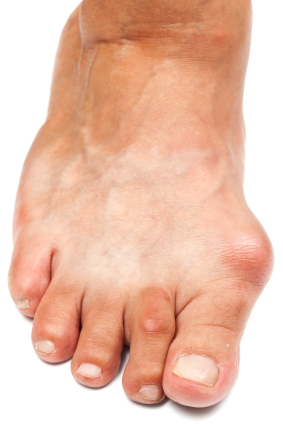A bunion, also known by the medical term hallux valgus, is a bony deformity in the foot at the base of the big toe joint.
The physical signs, such as bony deformation and changes in the toe joint, are usually the first to become evident and, in mild cases, the physical appearance is the only sign of bunions. However, the condition can also cause pain, inflammation and structural changes in the foot. In severe cases, surgery may be required to treat the condition, which is associated with other complications.
Physical Signs
The primary physical signs of a bunion include:
- Big toe pointing outward towards other toes
- Sticking out of the first metatarsal (foot bone)
- Swollen, bony lump on outside edge of the foot
- Thick, hardened skin underneath the big toe
- Calluses on the second toe
As the condition progresses, there may be significant changes to the structure shape of the foot, both in the big toe joint and other areas of the foot. This can lead to difficulty for individuals to find well-fitting shoes.
Symptoms and Complications
As a result of the changes in the structure of the foot, particularly the overlapping of the big and second toe associated with bunions, pain and inflammation in the area can often present.
Bursitis is a complication involving irritation of the bursa, the fluid-filled sac that cushions toe joint, which leads to inflammation, pain and tenderness in the area.
These symptoms may be intermittent or persistent and are often worsened by ill-fitting shoes.
Additionally, affected individuals may have difficulty moving their big toe, as a result of the pain and structural changes. This can also affect their ability to walk normally.
Most individuals with bunions with never experience significant issues related to the bone deformity, however, some patients with severe untreated cases may be affected by complications. These may include arthritis in the joint of the big toe in the foot, as well as deformity and displacement of the joint of the second toe.
For this reason, all individuals with signs of bunions should be diagnosed and examined for risks of severe changes in the foot. This will help to direct treatment decisions and prevent unnecessary worsening of the condition.
Surgical Complications
Ironically, the surgical treatment of bunions can cause complications that may be worse than the original condition. This occurs in less than 10% of patients that undergo surgery for bunions. The complications may include:
- Infection
- Deep vein thrombosis (DVT)
- Toe joint stiffness
- Delayed, misguided or failed bone healing
- Pain under the ball of the foot
- Peripheral nerve damage
- Persistent inflammation and pain of the foot
- Thicken scar tissue
- Complex regional pain syndrome (chronic burning pain in limb)
In some cases, the bone deformation of the bunion can also return. Depending the specific case, there may be a need for further surgery to address the complications and improve the health outcomes of the individual.
Patients undergoing bunion surgery should be aware of the possible complications to enable them to seek medical advice if they experience early signs of the complications. In this way, appropriate management techniques can be employed as soon as possible to prevent worsening of symptoms.
If you believe you may be experiencing the symptoms of bunions, contact Achilles Podiatry for further evaluation and treatment.
Source: news-medical

